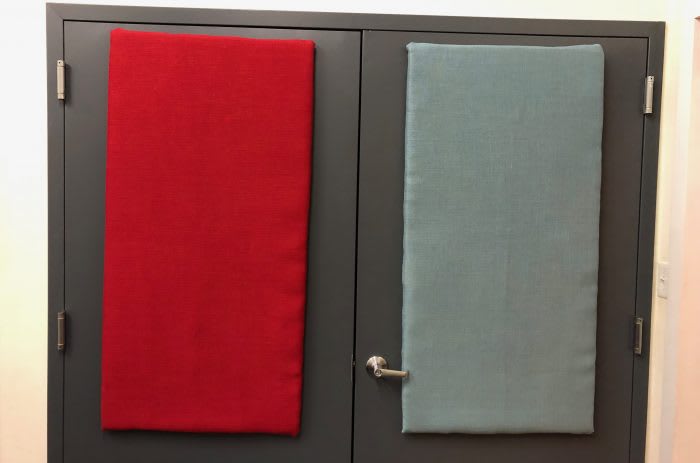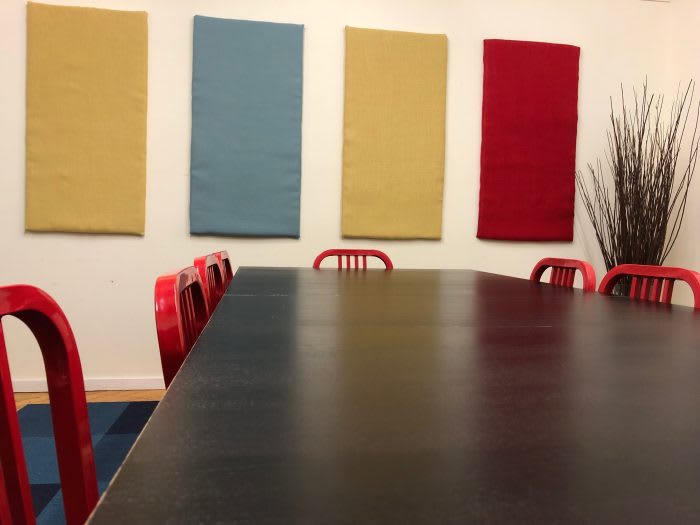This article was written by Neil F. Carlson, Co-Founder & CEO, Brooklyn Creative League
- Noise is one of the top complaints of the workplace.
- Managing sound is a challenge for coworking operators, they need to maximize revenue without making a space too dense.
- Soundproofing can be successfully done on a budget when space operators combine savvy design with a deeper understanding of how sound travels.
Managing sound is among the biggest challenges any coworking operator faces, in both the design and daily operation of their space. On one hand, operators need to maximize their revenue; on the other hand, if you make it too dense, the space becomes unusable due to noise pollution. Plus, members have different sensitivities to sound, different personalities (some people love background noise, others need quiet).
Suggested Reading: “3 Invisible Elements that Greatly Impact Workplace Productivity”
But, with a little knowledge of how sound travels, along with some savvy design choices, space operators can create spaces that work for all their users. The best part? It doesn’t need to break the bank. Here’s how to soundproof your space on a budget.
Mitigation Strategies: Blocking, Absorbing, and Masking
Blocking sound comes down to putting a lot of mass between the noise source and your members’ ears. Drywall is a great — and relatively inexpensive — material for blocking sound.
Two layers is ideal, but you can get away with one layer if you also place insulation between the inner and outer panels. Stay away from rigid materials like glass and steel, which can amplify noise when they vibrate. Use solid doors, too, ideally with acoustical seals around the jamb. Whatever you do, block any open-air passages–cracks, holes, seams. A surprising amount of sound can come through even a tiny hole.
Absorbing sound consists of using sound-absorbing materials to stop sound waves from bouncing around. Ideally, you want to cover around 30% of the surface in any room with sound-absorbing materials. For floors, an inexpensive rug can do wonders. Rubber flooring and carpeting are also good options.
Ceilings are a bit more tricky. Dropped ceilings with acoustical panels are a good – if not terribly attractive — option. Another option is hanging baffles. At Brooklyn Creative League, we were able to achieve a similar effect by stuffing our ceiling joists with fiberglass insulation, then covering it with a clear plastic vapor barrier and chicken wire to create an industrial-chic aesthetic that is cheap to build and has amazingly good acoustics.
For walls, acoustical panels are by far the best option. If you want a really sharp look, these fabric-covered panels from Audimute are great. They come in various sizes and colors and include clips for wall-mounting.
But they’re not cheap.
If you’re looking for a less pricey option, and you don’t mind some DIY effort, you can make your own sound panels for pennies. Get yourself some standard fiberglass insulation panels, cover them in colored burlap, and use spray glue to assemble them.
Suggested Reading: “The ABC of Acoustics: 3 Ways to Reduce Noise in Open Workspaces”
Just cut the burlap to size, spray the surface of the panel, and glue the burlap to the panel, folding the edges in like wrapping a present. To mount the panels, we used these impaling clips for sheetrock (screw the clips to the wall, impale the panel on the clips), and rare-earth magnets (glued between the panel and the burlap seams) to mount on metal doors. We did our entire conference room for a couple hundred bucks.


Masking sound is an important complement to the other two mitigation strategies. The human ear is optimized for discerning speech, which is why it’s so easy to be distracted by someone talking in the same room.
Ideal office masking would be in the “important” frequencies of human speech, around 1-5kHz, but blasting white noise in this range can be harsh on the ears. Lower frequencies (pink noise) is generally much easier on the ears, but not as good at masking speech, so you’ll likely have to find a compromise frequency.
We’ve found that sound machines are the best option for achieving that compromise noise. Be sure to buy a device with different frequencies, so you can play around with the pitch that works best for your space. We have this LectroFan, which has a range of frequencies and sips electricity. If you have a sound system in your space, mynoise.net has a ton of different sound filters, all free.
Whatever you do, don’t use music to mask noise. It contributes to the background din, and creates distraction as our brains naturally try to follow the melody and make sense of the lyrics.
Social Design: Space, Individual Behavior, Cultural Expectations
Of course, the best way to deal with sound is to deal with the source: your members.
That’s why social design is indispensable to any sound mitigation strategy. When designing your space, make sure to create different zones to accommodate different levels of noise. For instance, we have a “no noise” zone for people who need to focus. We also have a surfeit of phone booths and meeting rooms.
Just as important, we have a set of written “phone guidelines” that clearly articulate what the norms and expectations are around phone calls. These guidelines outline what we expect from individuals — keep your voice low; if you have a call longer than 20 minutes, do it in a phone booth; if you have an issue with a noisy neighbor, deal with them directly and courteously — but also establish the cultural expectations for our space.
At the end of the day, all the technology and design can’t stop people from being loud and rude, and having clear guidelines makes it easier to be a good neighbor–which is really what makes a great coworking space.


 Dr. Gleb Tsipursky – The Office Whisperer
Dr. Gleb Tsipursky – The Office Whisperer Nirit Cohen – WorkFutures
Nirit Cohen – WorkFutures Angela Howard – Culture Expert
Angela Howard – Culture Expert Drew Jones – Design & Innovation
Drew Jones – Design & Innovation Jonathan Price – CRE & Flex Expert
Jonathan Price – CRE & Flex Expert














